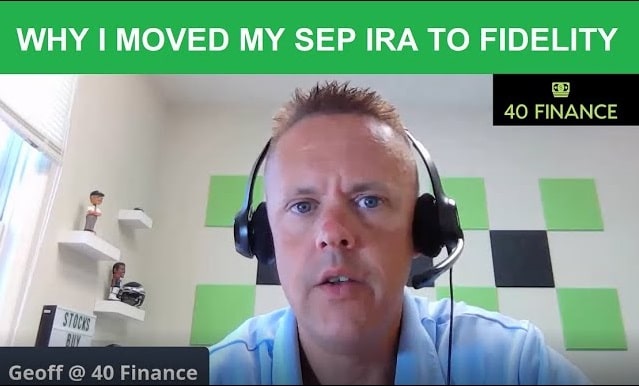
I recently made the choice to return to my entrepreneurial roots and focus on my independent media and marketing business. This transition gives me the opportunity to utilize a SEP IRA to save for retirement since I am a small business owner.
I already had a SEP IRA from several years ago when I started my business. A lot of things have changed since then, most notably my obsession with the stock market, so I knew I would be making some adjustments to the old plan. Most of my existing funds were allocated to a range of American Funds mutual funds.
Ultimately I decided to move my SEP IRA to Fidelity Investments so that I could more efficiently manage the investments. This video discusses why I made the move, how the transfer process works, and how long it took my assets to be transferred. If you are interested in opening a SEP IRA then I think you will enjoy the video.
This video is NOT a paid advertisement for Fidelity Investments and it is important that you discuss your SEP IRA options with a certified financial advisor (which I am NOT) before proceeding.
This post originally appeared as a video on the 40 Finance YouTube Channel
Preview Text:
For simple example purposes, I think fidelity has a pretty good definition here. Self employed individuals and small business owners get access to tax deferred benefit when saving for retirement. So I have a small business, a single owner business, and a SEP IRA works really well. I do digital marketing consulting. I have this 40 finance channel, and a couple other things that I work on behind the scenes, but at the end of the day, it's just me. And that's what makes the SEP IRA super attractive from my standpoint, because it gives me a lot of flexibility.
And normally if you have an employee with a SEP IRA, you have to match contributions in some way. I don't know all of it because I don't have employees. Uh, but if you are an individual, I definitely recommend talking to your financial advisor to see if this is a plan that may work for you. The big advantage to this whole thing, at least from my point of view is the contribution amount that you can put in. And this is IRS website and you see right here at the top 25% of your compensation. Now I believe compensation is different than profits. Compensation is actually what you pay yourself out of the company. So keep that in mind, or it can go up to $57,000. So if I compensated myself $40,000 from my business, after all my expenses, profits and everything, I paid myself $40,000.
Then under these guidelines, I would be allowed to contribute $10,000 of that to the SEP IRA. Now to hit that $57,000 threshold, I guess you'd have to times that by four, right? So you'd have to be in some neighborhood of $228,000 compensation, not profits compensation, uh, in order to hit that 25% is a nice place to be as far as having the opportunity, to invest that and avoid front end taxes. So that's a brief overview of what a SEP IRA is. Again, not for everybody. You can't do it. If you're working a nine to five, if you're a W2, you'd have to find a way to have a business. So again, financial advice from a professional is super important here.
So bottom line, the reason I transferred my SEP IRA from a local investment firm to Fidelity basically comes down to choices. With Fidelity, I can manage my own set by IRA choosing from almost any possible investment platform on the planet. So it can be stocks, it can be bonds ETFs. And so the wide range of investment options, not to mention the ability to change my holdings at any time, sell assets, all those things. Even if I want to transfer money out if something were to go wrong, that's really attractive for me.
So to me, the most amazing experience here with Fidelity is that they basically did all of the transfer work for me. So this is a standard URL, fidelity customer service transfer assets. This is exactly where I started my journey. The bottom line is you hit that blue button in the middle. There's a host of questions that come through. You need to have a statement from your existing account and Fidelity transfers from almost every imaginable broker. All of the assets that I had were held with a bigger company, Equitable.com.
You start here to start a transfer and I made zero calls. I went through, I had my account statement. I typed in my account numbers and Fidelity did all the work. I did made one phone call because I started the transfer and it was so easy that I called 1-800 whatever it is. And I just said, Hey, here's what I did. Can you just double check that everything looks good. And the woman on the other line confirmed it and said we'll take it from here. And sure enough, five to seven days later, I can't remember the exact timeframe, but it was very quick. All of my assets were over at Fidelity.